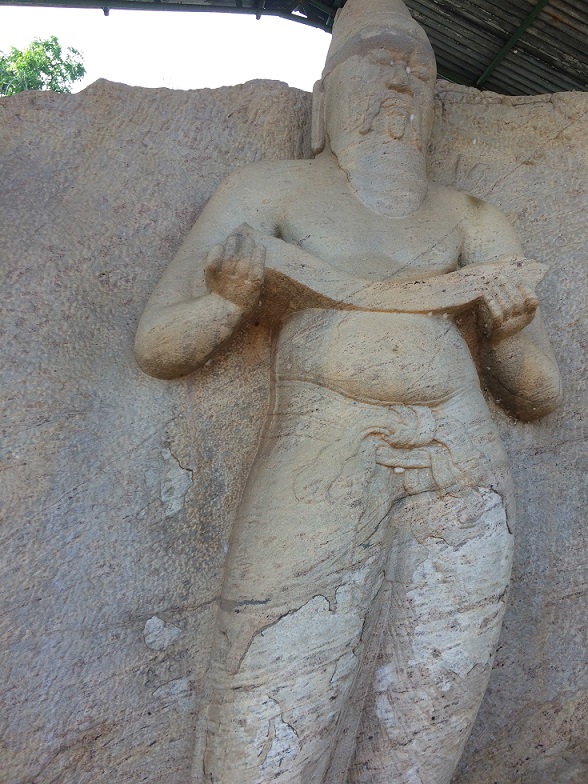Dr Sudath Gunasekara 2. July.2015
Photo by Dr. Achala Gunasekara Rockwell Figure: King Parakramabahu 1
The above statue is widely accepted as the figure of Parakramabahu the Great. But it also has been interpreted as a statue of a sage, either Agastya or Pulasthi. Two reasons are adduced by those who call it a stature of a sage. First, its proximity to the Pothgul Viharaya; and the other, more importantly a visible Punanula that runs diagonally across the shoulder of the statue from left to right. Both Bell and Paranavitana have interpreted it as a Punanul (a sacred thread). Probably in keeping with the scholastic traditions they must have conceived this as that of a sage rather than that of a human. Paranavitana later has interpreted it as that of Parakramabahu as well
But as an ordinary observer I see the so-called punanula as the grain of the rock that is quite obvious on the naked eye. Though this line is more conspicuous than others one can see many more similar linens all over the statue running in the same direction.Furthermore he same pattern could be seen even in other statues both in Anuradhapura and in Polonnaruwa. The most conspicuous of these grains is displayed on the Galviharaya statues in Polonnaruwa. The Standing Buddha- been the most conspicuous among them. Therefore I opine this line as the simple grain of the natural rock on which the statue is carved.
This argument is further confirmed by the fact that this ‘Punanula’ (sacred thread) is clearly visible running over the object held in the hands of the statue. On the other hand if it was a sacred thread it could never be visible running over the object; it should be placed under the object as a thread worn on the body of the person who is holding the object. Therefore I think the idea of a Punanula is only an esthetic invention. .Any student of basic geology who is familiar with the general geological formation and the trend line pattern of this part of the Island will vouch for this argument.
The fact that this is found on the tank of the Sea of Parakkrama and it is also accepted to have been built during the reign of Parakaramabahu the Great 1 further makes it more probable that it is the Statue of Parakkramabahu the Great and no one else. The fact that the statue depicts a majestic figure with a grave expression also support that this statue represents the colossal figure of the King. . According to Senarath Paranavithana this statue is an embodiment of strength, majesty and dignity.
The object held by the hands is also interpreted as that of an ola leaf book may be to prove the original identification of the statue with a sage. There is also another opinion that the object is a “yoke” of kingship. I understand that there is another reference to the yoke being used as the symbol of Rroyal authority mentioned in the Panakaduwa Tamba sannasa where King Vijayabahu of Polonnaruwa handing over a nindagam to his Army Commander after the completion of a war against the enemy. This brings us to a new notion of the yoke (Viyagaha) being used as a mace, the modern symbol of power and authority used in a modern parliament. Also from this one could surmise that the yoke would have been used in ancient Lanka as a symbol of Royal power, on occasions where Royal power is displayed. The yoke an important indigenous tool used in ploughing would have been definitely more appropriate and meaningful for an agricultural society than a modern mace probably adopted from a Yagadawa in the hands of Hanuma the monkey King in the Ramayana.
Naturally the Great King being the greatest tank builder of the Sinhala nation must have caused to erect his statue on the bank of the greatest irrigation feat of ancient Sri Lanka overlooking his pet project, the greatest achievement of Parakramabahu the Great with the yoke held in the hands to depict the authority of royal power he swayed over his Kingdom, Sri Lanka.

